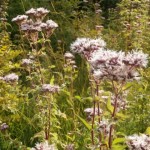
During September the pace of life in the wildflower garden begins to slow down.
With days shortening, many birds frantically feast on the last few insects in an attempt to put on as much weight as possible before the long journeys that they will soon face. On warm days, look out for Swallows and House martins gathering on south facing rooftops in an attempt to absorb some of the heat. Swallows are the first to leave but House martins always seem more reluctant, with most hanging on well into October. This month sees the first berry crops ripening, notably bramble which is spectacular in September providing ample feeding opportunities for both birds and humans alike!
Most of our native plants have flowered by now and are setting seed, but late flowering species, all of which are still in bloom this month, include Autumn hawkbit, Fleabane, Toadflax, Devils bit scabious, Gypsywort, Hemp agrimony, Autumn crocus, Nettle leaved bellflower, Tansy, Vervain, and Water mint.
One other much-overlooked plant that is flowering this month is Ivy. Most gardens will have some Ivy already, and if you allow some to grow in a south facing corner, perhaps over a fence panel you will create the perfect September suntrap for late broods of summer butterflies. Indeed ivy can act as a magnet for all manner of insects this month, and can often seem alive with the humming of bees and hoverflies on warm September days.